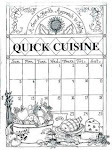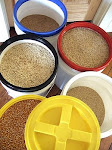
Today millet ranks as the sixth most important grain in the world, sustains 1/3 of the world’s population and is a significant part of the diet in northern China, Japan, Manchuria and various areas of the former Soviet Union, Africa, India, and Egypt.
Millet was introduced to the U.S. in 1875, was grown and consumed by the early colonists like corn, then fell into obscurity. At the present time the grain is widely known in the U.S. and other Western countries mainly as bird and cattle feed. Only in recent years has it started to make a comeback and is now becoming a more commonly consumed grain in the Western part of the world.
Millet is a tall erect annual grass with an appearance strikingly similar to maize. The plants will vary somewhat in appearance and size, depending on variety, and can grow anywhere from one to 15 feet tall. Generally the plants have coarse stems, growing in dense clumps and the leaves are grass-like, numerous and slender, measuring about an inch wide and up to more than 6 feet long.
Millet is highly nutritious, non-glutinous and like buckwheat and quinoa, is not an acid forming food so is soothing and easy to digest. In fact, it is considered to be one of the least allergenic and most digestible grains available and it is a warming grain so will help to heat the body in cold or rainy seasons and climates.
Millet is tasty, with a mildly sweet, nut-like flavor and contains a myriad of beneficial nutrients. It is nearly 15% protein, contains high amounts of fiber, B-complex vitamins including niacin, thiamin, and riboflavin, the essential amino acid methionine, lecithin, and some vitamin E. It is particularly high in the minerals iron, magnesium, phosphorous, and potassium.
The seeds are also rich in phytochemicals, including Phytic acid, which is believed to lower cholesterol, and Phytate, which is associated with reduced cancer risk.
There are many cooking variations to be found for millet. A good general guideline is to use 3 parts water or stock and 1 part grain, add grain to boiling water, and simmer covered for approximately 30 minutes or until water is completely absorbed. Remove from heat and let steam, covered for ten minutes more.
The grain has a fluffier texture when less water is used and is very moist and dense when cooked with extra water.
The flavor of millet is enhanced by lightly roasting the grains in a dry pan before cooking; stir constantly for approximately three minutes or until a mild, nutty aroma is detected.
If millet is presoaked the cooking time is shortened by 5 to 10 minutes.
Millet is delicious as a cooked cereal and in casseroles, breads, soups, stews, soufflés, pilaf, and stuffing. It can be used as a side dish or served under sautéed vegetables or with beans and can be popped like corn for use as a snack or breakfast cereal. The grain mixes well with any seasoning or herbs that are commonly used in rice dishes and for interesting taste and texture variations it may be combined with quinoa and brown or basmati rice.
Millet may also be sprouted for use in salads and sandwiches.
Millet flour produces light, dry, delicate baked goods and a crust that is thin and buttery smooth. For yeast breads up to 30% millet flour may utilized, but it must be combined with glutinous flours to enable the bread to rise. For a delightful "crunch" in baked goods, the millet seeds may be added whole and raw before baking.
Properly stored, whole millet can be kept safely for up to two years. The grain should be stored in tightly closed containers, preferably glass, in a cool dry place with a temperature of less than 70° or in the refrigerator. The flour deteriorates and becomes rancid very rapidly after it is ground, so it is best to grind the flour right before it is to be used.
Millet is a highly nutritious, healthful and versatile grain that would be a worthy addition to anyone’s diet.





 Check out my new eBook - Quick Cuisine Cookbook
Check out my new eBook - Quick Cuisine Cookbook